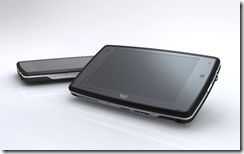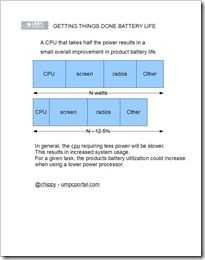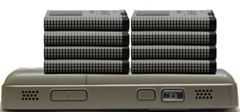We’ve been talking about the area of mobile internet-connected devices between the smartphone and notebook for a long time now. Many companies have tried with many many different designs but in reality, none of them have been a success. OQO, Flipstart, Wibrain and Raon Digital are proof that it’s a market where many are going to fail before a winner comes along but what is it going to take to make that winner and how close are we to it? Where are we on the Mobile Internet Timeline?
There are three components to a successful mobile internet product. Hardware (including technology and design), software (including UI, apps and community) and the magic pixie dust that is the combination of pricing, branding, distribution and marketing needed to bring the device to the people in just the right way. Unfortunately I don’t know enough about marketing to be able to comment (apart from the fact that I think that certain marketing teams are easily capable of making it happen today) but my experiences with ultra mobile devices and customers over the last 3 years gives me some idea about what’s needed for the hardware and software components.
One of the keywords that I keep coming back to in this segment is the word ‘microblogging.’ In my mind, microblogging is the word that connects to all the elements that go to make up a good mobile internet device. I’ve listed those below.
- Portability and form factor
- Always-on, connected and fast in use
- Content, image and video creation, optimisation and playback
- Fully web capable
- Position awareness
- Local storage
- Capable of multiple communication methods
- Flexible, reliable and up-to-date software set
- Pervasive and low-cost mobile internet connectivity.
I talk a bit more here about my own ideal microblogging device and the markets it addresses but let’s focus on a more generic level here.
Of all the items listed above, the first two are the biggest issues. These are the ones that are limited by current technology and have prevented engineers from creating what could be the ideal device so lets take a closer look at these.
Portability
 It goes without saying; a mobile internet device needs to be portable but how portable is portable? Through my conversations with thousands of mobile computing and smartphone fans I’ve learned that it can be vastly different to many people although it largely centers around ‘the bag.’ If you’ve got a bag with you all the time (as I do, I hate carrying things in my pockets) then portability goes all the way up to 7 inch screens and nearly 2lb in weight. For those that are looking for a jacket pocket solution, forget anything over 4.8 inch and 1lb. One important thing to note though is that the smaller the device is, the easier it is to hold in one or two hands but that it gets harder to display information. Pixel density can only go so high before websites become unreadable and need to be zoomed. 4-5 inch, 250gm, 15mm thick and an 800×480 screen is going to be the target in my opinion for the next few years. How far away from that are we? We’re there already. Devices have already been designed with both X86 and ARM cores that achieve this size. [Example]
It goes without saying; a mobile internet device needs to be portable but how portable is portable? Through my conversations with thousands of mobile computing and smartphone fans I’ve learned that it can be vastly different to many people although it largely centers around ‘the bag.’ If you’ve got a bag with you all the time (as I do, I hate carrying things in my pockets) then portability goes all the way up to 7 inch screens and nearly 2lb in weight. For those that are looking for a jacket pocket solution, forget anything over 4.8 inch and 1lb. One important thing to note though is that the smaller the device is, the easier it is to hold in one or two hands but that it gets harder to display information. Pixel density can only go so high before websites become unreadable and need to be zoomed. 4-5 inch, 250gm, 15mm thick and an 800×480 screen is going to be the target in my opinion for the next few years. How far away from that are we? We’re there already. Devices have already been designed with both X86 and ARM cores that achieve this size. [Example]
Form Factor Style. Keyboard. Screen.
There’s no real answer here expect to say that most styles and form-factors in most materials are possible today. A keyboard creates a thickness problem and a folding screen option would be nice for the industrial designers but I’m confident that given current industrial design knowledge, materials, skills and production technologies, almost anything is possible today. Fasion changes but given economies of scale, anything should be possible.
Being always connected means not having to charge a device for a whole day of about 15 hours. This has been possible with mobile phones for along time but we’re talking about a different level of ‘always connected’ with a mobile internet device. This is not a device that will sit idle. Background software will be checking emails, waiting for instant messages, polling social networks, processing GPS signals, updating locations, checking for software updates, playing music, checking accelerometers and ambient light levels, scheduling alarms and the device will probably be in-use, with the screen backlight on, every 15 minutes during the day. Idle devices are a thing of the past and that’s where the technology challenge comes in. Running these scenarios on a phone architecture results in a dead battery within hours. I know because i’ve tested it!
Always-on Internet applications increases the average power requirement of a smartphone by a minimum of 1000% and up to 3000%
 The answer here is not to use the lowest power CPU but to use a very closely coupled hardware and software layer that can schedule events at the right times and make sure the device sleeps for as long as possible. In general, low power devices take longer to perform general purpose processing tasks so the power advantages are outweighed by the need to keep screens and radios active. In general, a device that can perform tasks quicker in processing ‘windows’ and then resume to a standby state is probably going to have the advantage. [See this article for more thoughts and view the image on the left.] How far away from that are we? Quite far. We’re in a very early stage of mobile internet software development and unless a golden bullet comes along in the form of new battery technology, the problem will need to be worked on for some time before true all-day mobile internet ‘computing’ is possible.
The answer here is not to use the lowest power CPU but to use a very closely coupled hardware and software layer that can schedule events at the right times and make sure the device sleeps for as long as possible. In general, low power devices take longer to perform general purpose processing tasks so the power advantages are outweighed by the need to keep screens and radios active. In general, a device that can perform tasks quicker in processing ‘windows’ and then resume to a standby state is probably going to have the advantage. [See this article for more thoughts and view the image on the left.] How far away from that are we? Quite far. We’re in a very early stage of mobile internet software development and unless a golden bullet comes along in the form of new battery technology, the problem will need to be worked on for some time before true all-day mobile internet ‘computing’ is possible.
Fast in use.
Getting a task completely quickly and efficiently means better user satisfaction and more productivity. The days of waiting 20 seconds for a web page to load on a smartphone are over and we need to be looking towards the sub 10-second page load. Ultimately, 5 seconds for every page on the internet. Not only that but applications need to start instantaneously and user interfaces need to react in a physical way in order for the device to become more a part of the user. How far away from that are we? Quite far. The new generations of smartphone are improving very well and reaching the 15 second average page load level along with having great almost instantaneous interfaces but its still the exception. UMPCs and netbooks are into the sub 10-second level for web page processing but still struggle to meet the battery life requirements when doing so. In general we need about 4x efficiency improvement from the X86 based devices and about 4 x processing power improvements in the ARM-based devices. Both sides are moving very quickly towards it but we’re a couple of years away from what I would call a thrilling experience.
Pervasive 3G networks
As for the rest of the list, we’re pretty much there now. Location, storage, video and software is available. It’s just a matter of sticking it al together in the right way and focusing on the limitations above.
The dream of that ultimate mobile internet communications device is spread wide across potential consumer base and the industry itself but we’ve still got a long way to go. 2009 is an early point on the timeline where although devices are possible, customers are burdened with issues. Be it battery life or slow web processing, heavy form factors or tiny screens. The good news is that everyone working in the industry is already working on those problems and we’re now only a short few years away from seeing devices that satisfy everyone.












I think you nailed it.
Personally, here are three of the most important factors (in no order);
Price
Battery life
Connectivity
The Viliv S5 comes to mind now. It’s clear it’s a very popular device even though it only meets the price and connectivity criteria. Its battery life might not be as good as most windows mobile smartphones but it offers the right price and tons of connectivity options.
I don’t know how soon x86-based MIDs will be able to do the always connected thing but definitely not with current hardware.
In order to provide an “always on” 3G/4G connection, total power consumption of the device as a whole has to go way down (battery life needs to be increased). Besides, cheap flat-rate unlimited wireless broadband needs to be readily available but with the current state of 3G service in the U.S. that seems like a dream. Currently $60 will get you a 5GB limit on most 3G networks so only corporate users find such data plans useful. People want to surf the web like they do on their home PCs and laptops (only on a smaller screen), unimpeded.
If one can get a solid 8-10 hours of 3G time on a ARM-based device or even a x86-based device for that matter coupled with cheap flat-rate unlimited wireless broadband service ($30-$50 max)……..then.
Japan’s PHS networks and services are a good example.
New article: MIDs, UMPCs, Smartbooks. Where Are We on the Timeline? http://bit.ly/crsXLr